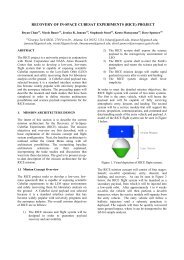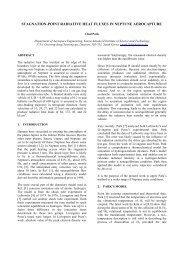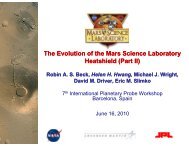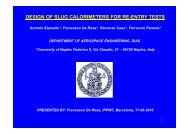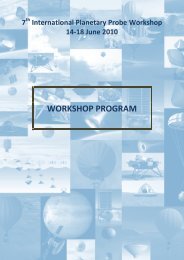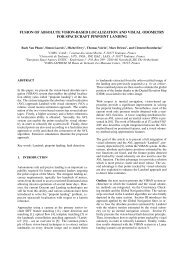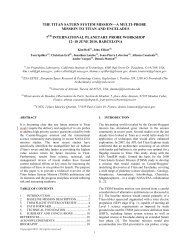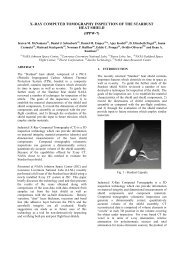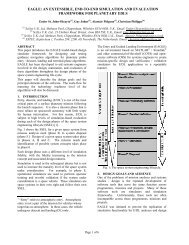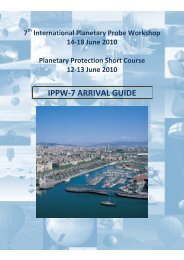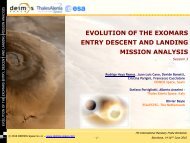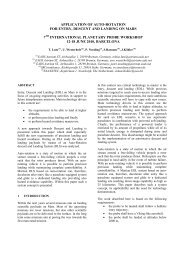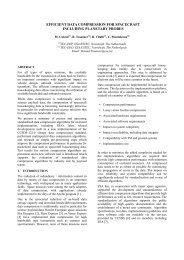Instrumentation on board the European Experimental Re-entry test ...
Instrumentation on board the European Experimental Re-entry test ...
Instrumentation on board the European Experimental Re-entry test ...
You also want an ePaper? Increase the reach of your titles
YUMPU automatically turns print PDFs into web optimized ePapers that Google loves.
<str<strong>on</strong>g>Instrumentati<strong>on</strong></str<strong>on</strong>g> <strong>on</strong> <strong>board</strong> <strong>the</strong><br />
<strong>European</strong> <strong>Experimental</strong> <strong>Re</strong>-<strong>entry</strong> <strong>test</strong> bed<br />
EXPERT<br />
F. Ratti, J. Gavira,<br />
A. C. Thirkettle, J. Thoemel, H. Ritter<br />
ESA-ESTEC
EXPERT C<strong>on</strong>sortium<br />
ESA funded project:<br />
Thales Alenia Space Italia as Prime C<strong>on</strong>tractor<br />
‣ Sub-c<strong>on</strong>tractors from 6 <strong>European</strong> countries (I, D, A, B, NL, CH)<br />
Set of 14 scientific payloads from <strong>European</strong> Institutes under ESA c<strong>on</strong>tract<br />
‣ experiments from CIRA, DLR, IRS, ALTA, INASMET, HTG, RUAG, VKI<br />
Russian supplier of launcher, DLS and recovery operati<strong>on</strong>s<br />
ESA provides technical management and technical support<br />
Thales Alenia Space ETCA
EXPERT <strong>the</strong> ESA <strong>test</strong> bed<br />
Class 2<br />
Class 1<br />
Class 3<br />
Built <strong>on</strong> experience gained in past<br />
projects -> ARD, X38, Huyghens<br />
Technological development beneficial for re-<strong>entry</strong> probes
EXPERT Objectives<br />
• Acquisiti<strong>on</strong> of in-flight measurements for<br />
critical AD/ATD phenomena (e.g. L/T, catalysis,<br />
gas surface interacti<strong>on</strong>s)<br />
• Validati<strong>on</strong> of CFD tools<br />
• Validati<strong>on</strong> of wind tunnel <strong>test</strong> facilities<br />
• C<strong>on</strong>solidati<strong>on</strong> of ground-to-flight extrapolati<strong>on</strong><br />
methodologies<br />
• To provide <strong>European</strong> industry with experience<br />
of re-<strong>entry</strong> vehicle manufacturing<br />
In Flight Experimentati<strong>on</strong><br />
CFD<br />
Ground Testing<br />
Facilities<br />
• To dem<strong>on</strong>strate re-<strong>entry</strong> technologies<br />
n<strong>on</strong> ablative nose<br />
metallic hot structure<br />
• To advance technologies for supers<strong>on</strong>ic descent<br />
and landing<br />
• Provide a <strong>test</strong> bed for re-<strong>entry</strong> experimentati<strong>on</strong>
EXPERT Missi<strong>on</strong><br />
RE-ENTRY capsule performing a sub-orbital ballistic flight at 5 km/s<br />
• Blunt nose, C<strong>on</strong>ical profiles<br />
• Lateral flat sides & Four fixed open flaps<br />
• 1.6 m length & 1.1 m diameter with mass below 450 Kg<br />
Submarine Launched by VOLNA (ICBM)<br />
Drogue supers<strong>on</strong>ic parachute and main parachute<br />
Soil landed and recovered in Kamchatka Peninsula<br />
3-rd stage<br />
PL z<strong>on</strong>e<br />
2-nd stage<br />
fuel tank<br />
2-nd stage<br />
oxidizer tank<br />
2-nd stage<br />
propulsi<strong>on</strong><br />
system<br />
1-st stage<br />
oxidizer tank<br />
1-st stage<br />
fuel tank<br />
1-st stage<br />
propulsi<strong>on</strong><br />
system<br />
VOLNA Launcher
Missi<strong>on</strong> animati<strong>on</strong>
Thermal protecti<strong>on</strong><br />
system of EXPERT<br />
1. TPS elements<br />
a. shell elements<br />
– Nose (highest temperatures ~2300K)<br />
– Skirt (moderate temperatures ~1500K)<br />
– Flaps (highest temperatures ~2300K)<br />
b. insulati<strong>on</strong> elements<br />
– Nose - Ceramic<br />
– Skirt - Metallic TPS<br />
– Internal Flexible Insulati<strong>on</strong> (IFI)<br />
– <strong>Re</strong>ar Thermal External<br />
Insulati<strong>on</strong> (RTEI)<br />
Internal<br />
insulati<strong>on</strong><br />
Skirt<br />
Nose<br />
Cold structure
<strong>Re</strong>-<strong>entry</strong> envir<strong>on</strong>ment<br />
free stream enthalpy [MJ/kg]<br />
0 2 8 18 32 50<br />
120<br />
100<br />
Dissociati<strong>on</strong><br />
O 2<br />
N 2<br />
velocity [km/s]<br />
altitude [km]<br />
80<br />
60<br />
40<br />
SHUTTLE<br />
APOLLO<br />
IXV<br />
20<br />
EXPERT<br />
0 2 4 6 8 10
Sensors and experiments <strong>on</strong> <strong>board</strong> EXPERT<br />
o<br />
o<br />
o<br />
o<br />
o<br />
o<br />
o<br />
o<br />
o<br />
o<br />
o<br />
o<br />
o<br />
o<br />
P/L #01 FADS Flush Air Data System<br />
P/L #02 PYREX Nose Heating<br />
P/L #03 PHLUX Catalysis<br />
P/L #04 Natural transiti<strong>on</strong><br />
P/L #05 Roughness induced<br />
transiti<strong>on</strong><br />
P/L #06 SWBLI <strong>on</strong>to Flaps<br />
P/L #07 SWBLI ahead of Flaps<br />
P/L #08 Flap Heating<br />
P/L #10 RESPECT Shock-layer<br />
chemistry through spectrometry<br />
P/L #11 Nose-TPS Step Juncti<strong>on</strong><br />
P/L #12 Base Flow<br />
P/L #13 SFS - Skin Fricti<strong>on</strong> Sensors<br />
P/L #15 Flying Winglet - Sharp Hot Structure “SHS”<br />
P/L #18 Inter-metallic TPS Flight Experiment
Nose<br />
C/C-SiC Nose Assembly (DLR)<br />
o 6 mm thick shell with 27 Carb<strong>on</strong> fibre<br />
layers<br />
o Interface with Hat profiles cured in hot<br />
press<br />
o Shell and Hat profiles pyrolised and b<strong>on</strong>ded<br />
toge<strong>the</strong>r with polymeric matrix<br />
o Optimised number of sheets per layer to<br />
avoid delaminati<strong>on</strong>s during curing<br />
o Liquid Silic<strong>on</strong> Infiltrati<strong>on</strong> (LSI) process to fill<br />
micro-cracks in <strong>the</strong> Carb<strong>on</strong> matrix<br />
o Machined Cut outs for sensors
Sensors <strong>on</strong> <strong>the</strong> nose : Flush air data system<br />
• Objectives;<br />
Determine pitch and side slip angle<br />
Stagnati<strong>on</strong> point heating<br />
<strong>Re</strong>c<strong>on</strong>struct free stream density<br />
• Sensors:<br />
Combined pitot probe/calorimeter<br />
• Principle Investigator:<br />
TG Goettingen, Germany<br />
• Tested in Plasma at DLR L3K and IRS
FADS sensor head assembly
Tubing and Wiring / Calorimeter installati<strong>on</strong>
Flush mounted air data system <strong>on</strong> ground <strong>test</strong><br />
• Dedicated holder built for <strong>test</strong> in plasma<br />
• temperatures were m<strong>on</strong>itored inside and<br />
<strong>on</strong> <strong>the</strong> exposed surface of <strong>the</strong> holder<br />
• Temperature reached <strong>on</strong> <strong>the</strong> surface of<br />
<strong>the</strong> sample up to 2000 C<br />
• Tested at stagnati<strong>on</strong> pressure of 1.3 bar
• Objectives<br />
Determine Nose Heating<br />
• Sensors:<br />
6 Miniaturized Pyrometers<br />
• Principle Investigator:<br />
IRS, Stuttgart, Germany<br />
Pyrometers for nose m<strong>on</strong>itoring
• Objectives:<br />
Determine gas phase state in<br />
shock layer<br />
• Sensors:<br />
Two spectrometers VIS NIR<br />
• Principle Investigator:<br />
IRS, Stuttgart, Germany<br />
Spectrometer windows – PL10
Spectrometer window Sensor Head Assembly<br />
Optical window for spectrometer<br />
measurements
Natural transiti<strong>on</strong> – PL4<br />
• Objectives:<br />
Determine <strong>on</strong>set of Naturar transiti<strong>on</strong><br />
• Sensors:<br />
Thermocouples<br />
Heat flux sensors<br />
Pressure sensors<br />
• Principle Investigator:<br />
CIRA, Capua, Italy<br />
• Expected transiti<strong>on</strong> at Mach 10 after peak<br />
heating<br />
q/qmax, <strong>Re</strong>/<strong>Re</strong>max [-]<br />
1.2<br />
1<br />
0.8<br />
0.6<br />
0.4<br />
0.2<br />
Mach<br />
heating<br />
<strong>Re</strong><br />
25.0<br />
20.0<br />
15.0<br />
10.0<br />
5.0<br />
Mach number [-]<br />
0<br />
0.0<br />
0 50 100 150<br />
time [s]
Roughness induced transiti<strong>on</strong> – PL5<br />
• Objectives:<br />
Determine Onset of Roughness<br />
Induced Transiti<strong>on</strong><br />
• Sensors:<br />
<strong>the</strong>rmocouples<br />
• Principle Investigator:<br />
V<strong>on</strong> Karman Institute, Belgium<br />
• Different roughness element tried before choosing<br />
<strong>the</strong> ramp c<strong>on</strong>figurati<strong>on</strong>
Shock wave boundary layer ahead of <strong>the</strong> flap – PL7<br />
• Objectives:<br />
Determine flap performance<br />
Heating/SWBL/transiti<strong>on</strong><br />
• Sensors:<br />
Thermocouples<br />
Pressure port<br />
Heat flux sensors<br />
• Principle Investigators:<br />
CIRA, Capua<br />
DLR Cologne<br />
• Tested in Scirocco in c<strong>on</strong>diti<strong>on</strong> representative<br />
of a point of <strong>the</strong> trajectory at high altitude<br />
100<br />
80<br />
Sampling<br />
Windows<br />
Point P1<br />
25<br />
20<br />
Altitude [Km]<br />
60<br />
40<br />
PWT<br />
Full duplicati<strong>on</strong><br />
15<br />
10<br />
Mach<br />
Point P2<br />
20<br />
Altitude<br />
Mach<br />
PWT<br />
Heat Flux<br />
Duplicati<strong>on</strong><br />
0<br />
0<br />
0 50 100 150<br />
Time [sec]<br />
5
Instrumented flap – PL6<br />
• Pressure ports located <strong>on</strong> 2 of <strong>the</strong> 4 flight<br />
flaps<br />
• Thermocouples located behind <strong>the</strong> flap
Thermocamera behind flap – PL8<br />
• Objectives:<br />
Determine heating<br />
• Sensors:<br />
IR <strong>the</strong>rmography<br />
• Principle Investigator:<br />
RUAG Aerospace, Wallisellen, Switzerland<br />
<strong>Re</strong>lay Lens Assembly<br />
Fiber Optics Cable<br />
NIR Camera
Skin Fricti<strong>on</strong> – PL13 and pressure sensors – PL12<br />
• Objectives:<br />
– Determine skin fricti<strong>on</strong><br />
• Sensors:<br />
– 2+2 pressure sensors and calorimeters<br />
• Principle Investigator: HTG, Goettingen, Germany<br />
• Objectives:<br />
– Determine base flow characteristics<br />
(heating, drag and stability)<br />
• Sensors:<br />
– 4+2 pressure sensors and calorimeters<br />
• Principle Investigator:<br />
– ALTA, Pisa, Italy
Instrumented TPS Juncti<strong>on</strong> – PL11<br />
• Objectives:<br />
– Detect and quantify catalytic effect<br />
• Sensors:<br />
– 7 Thermocouples<br />
• Principle Investigator:<br />
– V<strong>on</strong> Karman Institute<br />
radiative equilibrium temperature [K]<br />
2 5 0 0<br />
2 0 0 0<br />
1 5 0 0<br />
1 0 0 0<br />
9 3 s<br />
6 9 s<br />
5 7 s<br />
4 5 s<br />
8 1 s<br />
N 2<br />
B 5<br />
5 0 0<br />
N 1<br />
B 4<br />
B 1 B 2 B 3<br />
0 0 .1 0 .2 0 .3 0 .4 0 .5<br />
d ista n ce [m ]
Winglet in UHTC<br />
• Objectives:<br />
Test a sharp hot structure in flight c<strong>on</strong>diti<strong>on</strong>s<br />
• Sensors:<br />
Winglets are equipped with <strong>the</strong>rmocouples and<br />
pressure taps<br />
• Principle Investigator:<br />
CIRA, Capua, Italy
Sample of intermetallic material – PL18<br />
• Objectives:<br />
Test orthorhombic titanium aluminide (Ti2AlNb) in<br />
flight c<strong>on</strong>diti<strong>on</strong>s<br />
• Sensors:<br />
tile is equipped with <strong>the</strong>rmocouples<br />
• Principle Investigator:<br />
INASMET, San Sebastian, Spain
C<strong>on</strong>clusi<strong>on</strong><br />
• ESA has selected and managed <strong>the</strong> development of a set of c<strong>on</strong>sistent<br />
experiments for re-<strong>entry</strong> experimentati<strong>on</strong><br />
• Extensive CFD campaign and ground qualificati<strong>on</strong> campaign in <strong>European</strong><br />
ATD facilities (DLR, CIRA, IRS, VKI, ALTA)<br />
• Several Less<strong>on</strong>s learned<br />
• Demanding mechanical envir<strong>on</strong>ment for vibrati<strong>on</strong> and shock<br />
• Difficult IF between different TPS material (CMC and metallic TPS)<br />
• Vehicle and Payloads currently under integrati<strong>on</strong>, System <strong>test</strong> end 2010<br />
• <strong>Re</strong>adiness for flight early 2011 and expected launch mid 2011<br />
1.<br />
For more informati<strong>on</strong> visit ESA web site: www.esa.int/expert



